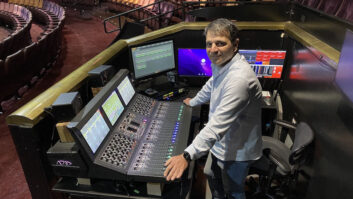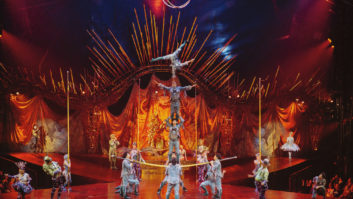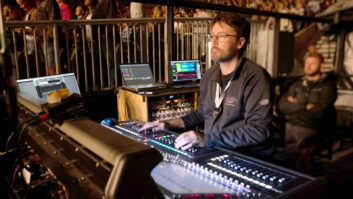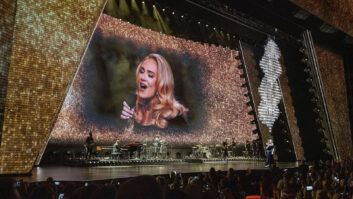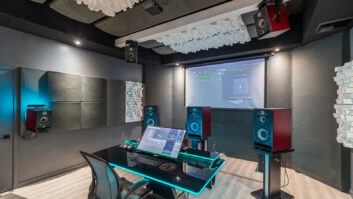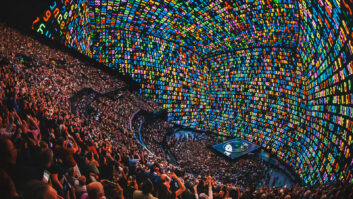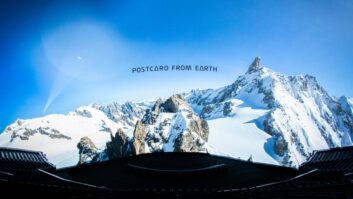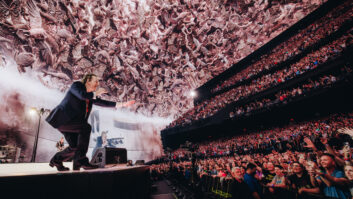The Cirque du Soleil juggernaut just keeps on going. The massively popular art-circus group has been bringing their unique blend of mind-boggling acts (with no animals), brilliant staging and distinctive music to millions of people around the world for more than two decades. With their ethnically diverse acts and universal themes, they have long since transcended their French-Canadian roots. Now, too, they have several incredible installations in Las Vegas. Indeed, the Cirque has become as much an institution in the new Vegas as Frank Sinatra and Wayne Newton were in the old one.
Cirque du Soleil’s KÀ is performed in a specially built theater in the Las Vegas MGM Grand hotel.
Their latest Las Vegas triumph, KÀ, is the most ambitious production in the group’s history. The magical acrobatics, martial arts and dance movements, puppetry, pyrotechnics and indescribable bombast don’t take place on a stage, per se, but on gargantuan moving hydraulic structures that rise and revolve and glide, and seem to change with each new scenario in what is, for the first time in the Cirque’s history, a coherent narrative story connecting the spectacular “acts.” Music and sound design have always been an integral part of the Cirque experience, but even more so in its installations, like this one at the MGM Grand, which was built at tremendous expense for this production. Jonathan Deans, who has been covered in these pages on other occasions, is the sonic mastermind behind the Cirque; this time, he and his team have really outdone themselves. For KÀ, there are nearly 5,000 loudspeakers being used every night: a pair in every seat and hundreds more strategically placed around the auditorium — ceiling, walls, everywhere! — along with 20 different sub channels. This takes the concept of “multimedia” to a whole new level. (The theater and set designer for KÀ is Mark Fisher.)
But there is also a traditional media aspect to KÀ: the good old stereo CD of the music for the show. Very quietly, the Cirque du Soleil has sold several million copies of music CDs — mostly at their performances, but not exclusively. A new CD like the KÀ soundtrack can be expected to sell a couple hundred thousand copies in its first few months, “and then it will just keep selling for eight, 10, 12 years — however long the production goes on,” says the CD’s Montreal-based co-composer/arranger/producer and principal engineer, Martin Lord-Ferguson, a veteran of more than 30 album projects in Canada before hooking up with the Cirque about three years ago. As with so many of the Cirque’s productions, the main composer was the gifted René Dupéré, whose music has become such an important part of the troupe’s aesthetic fabric. Together, Dupéré and Lord-Ferguson built their own soundtrack studio, Creations Netza, which is based in Montreal, but for this project, they set up shop just outside of Las Vegas so their work would be integrated into the show as it developed.
Composer/arranger/producer/engineer Martin Lord-Ferguson began working with Cirque du Soleil three years ago.
The studio comprises a mixture of top-of-the-line digital and analog machines: Pro Tools|HD and Digi 002; Manley mic pre’s and compressors; Vintech mic pre’s; GML 8200 EQs; TC Electronic System 6000 multichannel reverb/delay/room simulator; various Neumann, Brauner, Shure, Audio-Technica and DPA microphones; ADAM 5 speakers; and — the heart of room, really, for these composer/producers — a plethora of synths (Yamaha Motif, Kurzweill K2500, Roland XV-5080 and Ensoniq TS-10) and virtual synths (EastWest Symphonic and Percussive Adventures; Spectrasonics Atmosphere and Trilogy; Native Instruments Absynth; Liquid Loops, et al). According to Lord-Ferguson, the approach to this score was more grand and cinematic than on some previous Cirque productions, which were often centered around a small ensemble of live players. KÀ has live musicians, of course, and a large choral group (who sing in various real and invented languages — another Cirque tradition), as well as a considerable amount of programmed material. Because of the nature of the acts and the concentration required to perform many of the feats, this is not a show that unfolds with the same split-second pacing every night; in fact, it differs every night, so “technical wizard” Claude Chaput devised a system using a Tascam Giga sampler that allows for preprogrammed playback variations to be essentially mixed live with the band each night to reflect minute changes in the program pacing.
Long before Dupéré and Lord-Ferguson concerned themselves with the CD, they worried about the music and how it would fit in with the staging. “The first thing we did when we went to visit the KÀ hall while it was in construction,” Lord-Ferguson says, “was look at the schematics of Jonathan [Deans’] sound design, because it’s a very, very high-end and audacious system, with literally thousands of speakers everywhere. That was lots of fun because we had a hundred different channels and all the sub channels to fiddle with and move sound around, but we also had a lot of problems with phase coherence; a lot of calculations had to be done. We had an LCS board that Jonathan had set up, and we also mixed off a laptop. What we would do is record the band [in our studio] and then with [Wi-Fi] for the playback, we’d sit down in different seats and listen to how it sounded, and remix and rework the phasing.
“As soon as a song or a scene was done,” Lord-Ferguson continues, “we’d start mixing it. I’d work with René during the day preparing the scenes we hadn’t finished, and at night I’d mix the ones that were already done, and we’d try to mix it so they could use it in staging the next day.”
From left: composer René Dupéré, singers Élise Vella and Ella, and producer Martin Lord-Ferguson
photo: Nico World.com
The actual soundtrack recording work was done after the Vegas show had been completely designed, and it was constructed entirely back in Montreal. Because Lord-Ferguson and Dupéré wanted to enrich the music somewhat for the CD, they elected to make some orchestral recordings in Los Angeles at Paramount’s Studio M soundstage. (Rick Winquest engineered those sessions, using a Neumann M149 Decca Tree setup along with numerous spot mics; 48 tracks on Pro Tools in all.)
“We ended up doing lots of blending of the orchestra with a lot of sampled synths,” Lord-Ferguson says. “Some of the songs are almost 50/50 between samples and orchestra. For the live show in Vegas, there’s no real orchestra, but there is a real choir.” Some of the blending, Lord-Ferguson reveals, was to bolster the orchestra “because in certain sections, it didn’t feel like we had enough strings; it didn’t feel wide enough. So in [the song] ‘Love Dance,’ for example, there’s actually 70-percent synth in there, but it doesn’t really show because we were so careful in blending everything together, reverb-wise, to match the [orchestral] recordings and the synths. I would do a close-miking mixdown from the orchestral tracks, then the ambience mixdown and one from the very far room mics, and blend those with the synths and match it all with a System 6000.”
The KÀ show had 26 songs/pieces, the CD just 14, plus a pair of bonus tracks. But to Dupéré and Lord-Ferguson’s credit, the CD holds up remarkably well without visual accompaniment. It still has plenty of beauty and drama and pathos, as they had intended. “Before we did the mixing process,” Lord-Ferguson says, “soundwise it was a bit more edgy and aggressive, and we toned it down a bit and even softened it up in mastering because we wanted to make the CD sound like something people would still want to listen to in five or 10 years.”
And that’s one reason the Cirque du Soleil has stayed on top for so long: They’re always thinking ahead.
Browse through our expanded gallery on the Cirque Du Soleil phenomenon, KÀ
About Jonathan Deans, sound designer
Jonathan Deans is the man behind the changing sound environments of Corteo, his seventh sound design project for Cirque du Soleil. Having produced the soundscapes of Saltimbanco, “O”, Mystère La Nouba, ZUMANITY and KÀ, Deans finds Cirque’s “work-in-progress” and team-oriented creative approach very stimulating.
A successful child actor, Deans was fascinated by electronics at an early age. At 15, he joined the Royal Shakespeare Company, where his keen interest in sound began to blend with a theatrical context. After a spell as a sound engineer in the music industry, notably at Morgan Studios where he brushed shoulders with famous artists such as Cat Stevens, Paul Simon and Rick Wakeman, he made his way back to the theater to mix the sound for the musical comedy A Chorus Line. One success soon followed another and he became the sound recording operator for many productions including Evita, Cats, Bugsy Malone and The Sound of Music.
As soon as the West End caught wind of his success, Deans was hired as sound designer on the musical Marilyn. This was followed by work on shows including Time, Les Misérables, Mutiny, Jean Seberg and then on Broadway Ragtime, Fosse, King David, Damn Yankees, Taboo and Brooklyn, to mention a few.
His numerous achievements as sound designer have garnered him plenty of prizes. In 1998, for instance, while putting the finishing touches on the soundscape of La Nouba, he received the Entertainment Design Award for Production of the Year for his contribution to “O”.
About René Dupéré, composer/arranger
René Dupéré played a key role in shaping the artistic universe of Cirque du Soleil during its first 10 years of existence. His musical compositions for the shows Nouvelle Expérience, We Reinvent the Circus, Saltimbanco, Mystère, Alegría and KÀ reverberated—and continue to reverberate—well beyond the big top. Dupéré returned to Cirque du Soleil in 2004 for the first time since the creation of Alegría in 1994 to compose the music and create arrangements for the show KÀ.
In 1994, ’95, the albums Alegría and Mystère spent several weeks at the top of the Billboard charts in the world music category. In 1995 and again in 2004, the Festival International de Jazz de Montréal paid homage to the music of Dupéré and Cirque du Soleil.
This master of hybrid musical styles composed some of the music for the ceremonies commemorating the return of Hong Kong to China in 1997. The following year, Dupéré created the music for the world tour of Holiday on Ice, the Amsterdam-based ice ballet troupe. He has also written music for several television series and films.
Dupéré’s talents have earned him a number of awards and distinctions. He is a two-time recipient of the Society of Composers, Authors and Music Publishers of Canada (SOCAN) Hagood Hardy award. He is also known for “Ismya Vova,” composed for an Air Canada ad campaign, which won a Golden Award in 1998 at the New York Publicity festival for Best Original Music.
In 1998, Dupéré formed his own record company, Netza. He released his third album with this label in October 2002.
Interesting Audio Tricks
To fill the KÀ Theatre with sound takes 524,150 total watts of amplifier power pumping an intricately layered mix of sound effects and music to 4,774 loudspeaker drivers in 2,139 cabinets.
The sound system weighs 43,868 pounds.
The main audio system covers 1,980,000 cubic feet of air space.
Every seat in the KÀ Theatre has two speakers built into its head rest which allows sound effects to be targeted, manipulated and customized to any of 16 seating zones.
